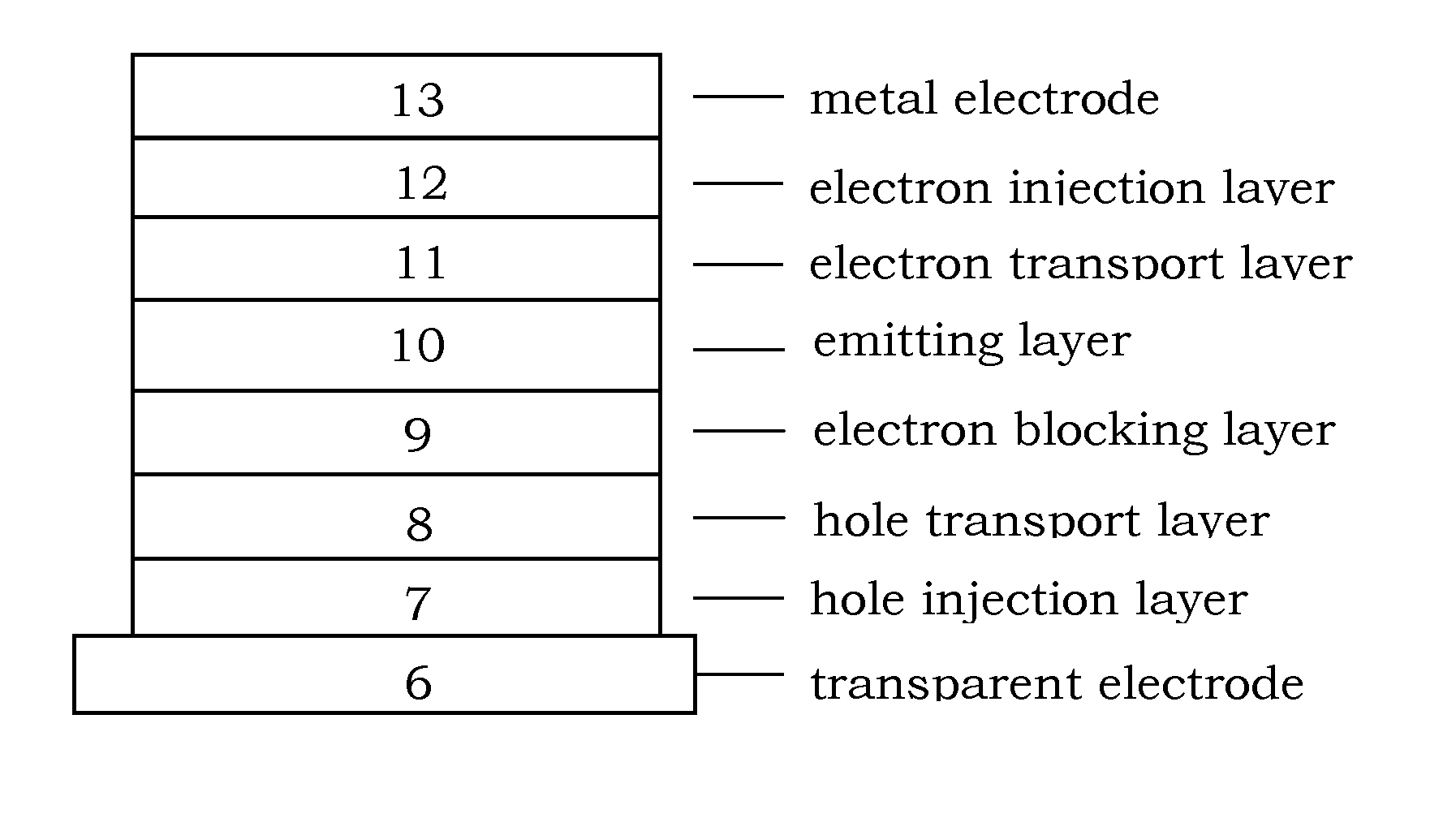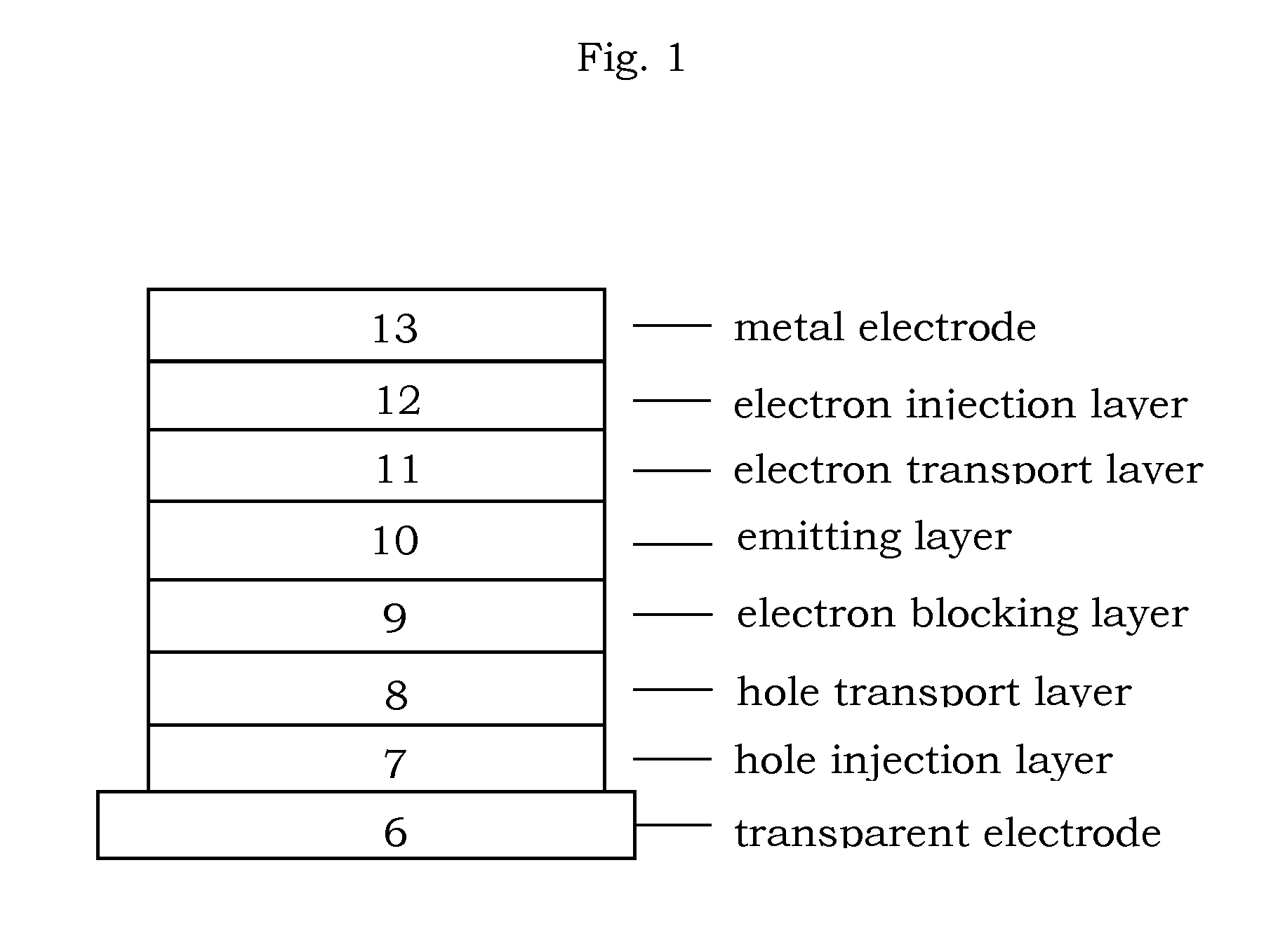Indenotriphenylene-based amine derivative for organic electroluminescent device
- Summary
- Abstract
- Description
- Claims
- Application Information
AI Technical Summary
Benefits of technology
Problems solved by technology
Method used
Image
Examples
example 1
Synthesis of Derivative A1
Synthesis of 2-(biphenyl-2-yl)-7-bromo-9,9-dimethyl-9H-fluorene
[0019]
[0020]A mixture of 35.2 g (100 mmol) of 2,7-dibromo-9,9-dimethyl-9H-fluorene, 21.8 g (110 mmol) of biphenyl-2-ylboronic acid, 2.31 g (2 mmol) of Pd(PPh3)4, 75 ml of 2M Na2CO3, 150 ml of EtOH and 300 ml toluene was degassed and placed under nitrogen, and then heated at 100° C. for 12 h. After finishing the reaction, the mixture was allowed to cool to room temperature. The organic layer was extracted with ethyl acetate and water, dried with anhydrous magnesium sulfate, the solvent was removed and the residue was purified by column chromatography on silica to give product (26.8 g, 63.0 mmol, 63%) as a white solid.
Synthesis of 12-bromo-10,10-dimethyl-10H-indeno[2,1-b]triphenylene
[0021]
[0022]In a 3000 ml three-necked flask that had been degassed and filled with nitrogen, 26.8 g (60 mmol) of 2-(biphenyl-2-yl)-7-bromo-9,9-dimethyl-9H-fluorene was dissolved in anhydrous dichloromethane (1500 ml), ...
example 2
Synthesis of Derivative A8
Synthesis of N-(9,9′-spirobifluorene-2-yl)-N-(biphenyl-4-yl)-10,10-dimethyl-10H-indeno[1,2-b]triphenylen-12-amine
[0031]
[0032]A mixture of 5 g (11.8 mmol) 12-bromo-10,10-dimethyl-10H-indeno[1,2-b]triphenylene, 6.8 g (14.1 mmol) of N-(biphenyl-4-yl)-9,9′-spirobi fluorene-2-amine, 0.03 g (0.11 mmol) of palladium(II)acetate, 0.04 g (0.11 mmol) of 2-(dicyclohexylphosphino)biphenyl, 1.7 g (17.7 mmol) of sodium tert-butoxide and 100 ml of toluene was refluxed under nitrogen overnight. After finishing the reaction, than cooled to room temperature. The organic layer was extracted with dichloromethane and water, dried with anhydrous magnesium sulfate, the solvent was removed and the residue was purified by column chromatography on silica (hexane-dichloromethane) to give product 5.8 g (yield 60%) as a yellow solid. MS (m / z, FAB+): 826.3; 1H NMR (CDCl3, 500 MHz): chemical shift (ppm) 8.78 (s, 1H), 8.73 (d, J=8.0 Hz, 2H), 8.70 (d, J=8.0 Hz, 2H), 8.78 (s, 1H), 7.77˜7.61 ...
example 3
Synthesis of Derivative A14
Synthesis of N-(biphenyl-4-yl)-9,9′-spirobifluorene-4-amine
[0033]
[0034]A mixture of 30 g (75.8 mmol) 4-bromo-9,9′-spirobi[fluorene], 15.3 g (90.9 mmol) of biphenyl-4-amine, 0.17 g (0.76 mmol) of palladium(II) acetate, 0.26 g (0.76 mmol) of 2-(dicyclohexylphosphino)biphenyl, 9.5 g (98.5 mmol) of sodium tert-butoxide and 300 ml of toluene was refluxed under nitrogen overnight. After finishing the reaction, than cooled to room temperature. The organic layer was extracted with dichloromethane and water, dried with anhydrous magnesium sulfate, the solvent was removed and the residue was purified by column chromatography on silica (hexane-dichloromethane) to give product 19.0 g (yield 52%) as a white solid.
Synthesis of N-(9,9′-spirobifluorene-4-yl)-N-(biphenyl-4-yl)-10,10-dimethyl-10H-indeno[1,2-b]triphenylen-13-amine
[0035]
[0036]A mixture of 4.5 g (10.6 mmol) 13-bromo-10,10-dimethyl-10H-indeno[1,2-b]triphenylene, 6.1 g (12.7 mmol) of N-(biphenyl-4-yl)-9,9′-spiro...
PUM
| Property | Measurement | Unit |
|---|---|---|
| Time | aaaaa | aaaaa |
| Electric potential / voltage | aaaaa | aaaaa |
| Efficiency | aaaaa | aaaaa |
Abstract
Description
Claims
Application Information
 Login to View More
Login to View More - R&D
- Intellectual Property
- Life Sciences
- Materials
- Tech Scout
- Unparalleled Data Quality
- Higher Quality Content
- 60% Fewer Hallucinations
Browse by: Latest US Patents, China's latest patents, Technical Efficacy Thesaurus, Application Domain, Technology Topic, Popular Technical Reports.
© 2025 PatSnap. All rights reserved.Legal|Privacy policy|Modern Slavery Act Transparency Statement|Sitemap|About US| Contact US: help@patsnap.com



